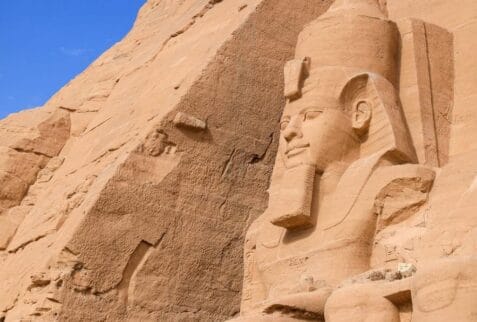Abu Simbel
The Abu Simbel Temple was carved into the belly of the mountain, 320 kilometers south of Aswan
The monument consists of two large temples carved by King Ramses II in 1250 BC. M in the rock! The facade of the Great Temple consists of four huge statues of the king sitting on his throne, and in the middle of the temple door are the four statues of King Ramesses.
The great temple at Abu Simbel would take nearly twenty years to build, and was completed in about 24 years of the reign of Ramesses the Great (which is equivalent to 1265 BC). It was dedicated to the gods Amun, Ra-Harakhty, Ptah, as well as to Ramesses. It is generally considered the most magnificent and beautiful temple commissioned during the reign of Ramesses II, and one of the most beautiful in Egypt.
in 1959, an international donations campaign to save the monuments of Nubia began: the southernmost relics of this ancient civilization were under threat from the rising waters of the Nile that were about to result from the construction of the Aswan High Dam.


One scheme to save the temples was based on an idea by William MacQuitty to build a clear freshwater dam around the temples, with the water inside kept at the same height as the Nile. There were to be underwater viewing chambers. In 1962 the idea was made into a proposal by architects Jane Drew and Maxwell Fry and civil engineer Ove Arup They considered that raising the temples ignored the effect of erosion of the sandstone by desert winds. However, the proposal, though acknowledged to be extremely elegant, was rejected
he salvage of the Abu Simbel temples began in 1964 by a multinational team of archeologists, engineers and skilled heavy equipment operators working together under the UNESCO banner; it cost some $40 million (equivalent to $377.42 million in 2022). Between 1964 and 1968, the entire site was carefully cut into large blocks (up to 30 tons, averaging 20 tons), dismantled, lifted and reassembled in a new location 65 meters higher and 200 meters back from the river, in one of the greatest challenges of archaeological engineering in history. Some structures were even saved from under the waters of Lake Nasser. Today, a few hundred tourists visit the temples daily. Most visitors arrive by road from Aswan, the nearest city. Others arrive by plane at Abu Simbel Airport, an airfield specially constructed for the temple complex whose sole destination is Aswan International Airport.
The complex consists of two temples. The larger one is dedicated to Ra-Horakhty, Ptah and Amun, Egypt’s three state deities of the time, and features four large statues of Ramesses II in the facade. The smaller temple is dedicated to the goddess Hathor, personified by Nefertari, Ramesses’s most beloved of his many wives The temple is now open to the public.



























